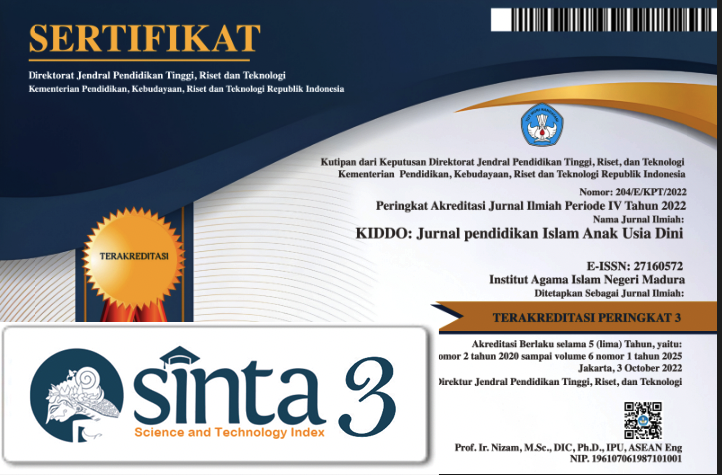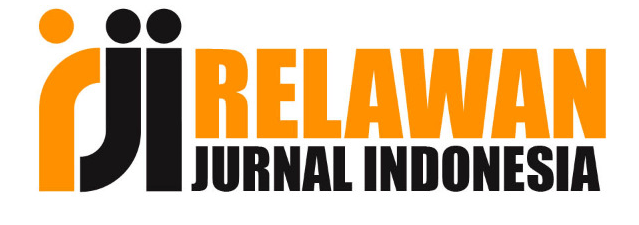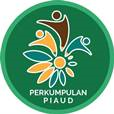Penerapan Media Loose Part untuk Kreativitas Anak Usia 5-6 Tahun
 Abstract views: 6718
,
Abstract views: 6718
,
 PDF downloads: 3808
PDF downloads: 3808
Abstract
Downloads
References
Casey, Theresea & Juliet Robertson. 2016. Loose Parts Play. Inspiring Scotland.
Fatmawijayati., J. 2018. Telaah Kreativitas. See discussions, stats, and author profiles for this publication at: https://www.researchgate.net/publication/328217424
Heldanita,. 2018. Pengembangan Kreativitas Melalui Eksplorasi. Golden Age; Jurnal Ilmiah tumbuh kembang Anak Usia Dini, Vol.3, No.1, maret 2018. E-ISSN: 2502-3519
Istianti., Tuti. 2013. Pengembangan Kreativitas Anak Melalui Pemanfaatan Lingkungan Sekitar Sebagai Media Belajar Bagi Anak Usia Dini. Cakrawala Dini Jurnal Pendidikan Anak Usia Dini. https://doi.org/10.17509/cd.v4i2.10393
Mulyati, S., & Sukmawijaya. 2013. Meningkatkan Kreativitas Pada Anak. Jurnal Inovasi dan Kewirausahaan-Seri Pengabdian Masyarakat 2013, Volume 2, No.2, Mei 2013, Halaman 124-129. Universitas Islam Indonesia.
Mulyana., Aina. 2017. Pembelajaran Abad 21 Dan Kurikulum 2013. https://ainamulyana.blogspot.com/2017/03/pembelajaran-abad-21-dan-kuikulum-2013.html
Montolalu. W (2008) Bermain Dalam Kelompok, Bermain Bola, Bermain dengan Angka. Jakarta: Grasindo
Nurjanah. E. N. 2020. Pembelajaran STEM Berbasis Loose Parts Untuk Meningkatkan Kreativitas Anak Usia Dini. Jurnal AUDI; Jurnal Ilmiah Kajian Ilmu Anak dan Media Informasi PAUD, JAI V(1) (2020) ISSN 2528-3367 pp;19-31
Prameswari. W.T. & Lestariningrum, A. 2020. STEAM Based Learning Strategies by Playing Loose Parts for the Achievement of 4C Skill in Children 4-5 Years. Efektor, Volume 7 Issue 1, 2020 pp;24-34. https://doi.org/10.29407/e.v7i2.14387
Shabrina. Ega. & Lestariningrum, Anik. 2020. The role of loose parts play in logical thinking skill in KB Lab school. Journal of Early Childhood care and Education, Vol 3(1) March 2020, pp.36-48. E-ISSN 2615-1413 https://doi.org/10.26555/jecce.v3i1.1679
Wahyuningsih, S., dkk. 2020. Efek Metode STEAM pada Kreativitas Anak Usia 5-6 Tahun. Jurnal Obsesi:Jurnal Pendidikan Anak Usia Dini, Volume 4, Issue 1 (2020), pp; 305-311. Surakarta : Universitas Sebelas Maret. Doi: 10.31004/obsesi.v4i1.305
-
The journal operates an Open Access policy under a Creative Commons 4.0 International license. The terms of the license are:
Share— copy and redistribute the material in any medium or format
Adapt— remix, transform, and build upon the material for any purpose, even commercially.
1. Authors retain copyright and grant the journal right of first publication with the work simultaneously licensed under a Creative Commons License.that allows others to share the work with an acknowledgement of the work’s authorship and initial publication in this journal
2. Authors are permitted and encouraged to post their work online (e.g., in institutional repositories or on their website) prior to and during the submission process, as it can lead to productive exchanges, as well as earlier and greater citation of published work (See The Effect of Open Access).
Jurnal Kiddo is licensed under a Creative Commons
n Access).














